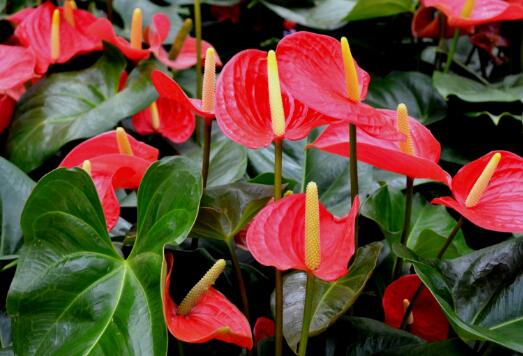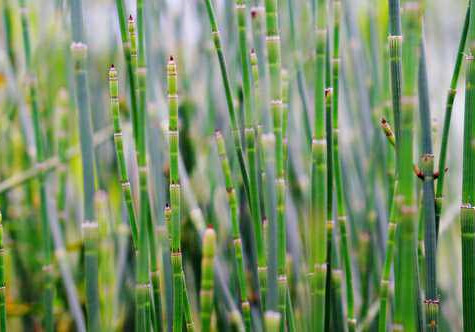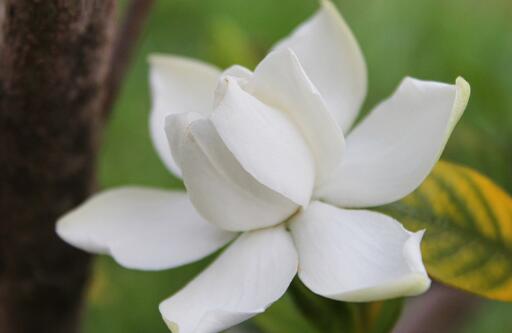"Araceae" Anthurium cultivation methods and matters needing attention! Is it poisonous? How do the leaves turn yellow and scorched?
Anthurium, also known as fire crane flower, candle, because of its broad green leaves, stamens such as Buddha flame, petals red like fire, full of auspicious and festive meaning, so deeply loved by everyone. How to raise Anthurium andraeanum? Now let's introduce the culture methods and points for attention of Anthurium andraeanum.

Perennial evergreen herb of Anthurium andraeanum, having waxy leaves and heart-shaped leaves decorated with flame inflorescences around orange spiral stamens, so it is also known as "flame rose" or "cow tongue". Can blossom all the year round, the general plant grows to a certain period of time, each axilla can produce buds and blossom.
Anthurium andraeanum can also absorb the exhaust gas discharged by the human body, absorb all kinds of harmful gases left in the decoration, and at the same time keep the air moist and avoid the dryness of the nasal mucosa of the human body. When Anthurium blossoms, it is like a small palm and a small flame, which is very suitable for viewing.
The flower language of Anthurium andraeanum: great ambition, enthusiasm and blood.
Family Culture of potted Anthurium andraeanum
Soil selection
Be sure to disinfect the soil before planting, but if you are suddenly preparing professional soil bought from a professional store, you can skip this step, so that Anthurium andraeanum is less likely to suffer from diseases and insect pests in the later stage of growth.
Temperature requirement
The most suitable growth temperature of Anthurium andraeanum is 14-35 ℃. When the winter temperature is lower than 10 ℃, Anthurium andraeanum is prone to frostbite and increase in time. When the summer temperature is higher than 35 ℃, sprinkle water around Anthurium andraeanum to cool down. The temperature is high in summer, pay attention to ventilation and sprinkling water, and cultivate in greenhouse in winter.
Illumination factor
Anthurium likes sunlight, vegetative growth stage, increase light, promote growth; during flowering, reduce light to prevent bud discoloration and affect ornamental. It is difficult to blossom if there is not enough sunlight during the growing period, but Anthurium andraeanum is not suitable for direct sunlight and will burn leaves. The best way is to put Anthurium andraeanum in a cool place and be exposed to astigmatism, so as not to be too cool. It is protected from the burning of strong light and refracted sunlight for photosynthesis.
Notes on fertilization
Anthurium likes fertilizer, the demand for magnesium fertilizer is higher, it is best to go to a professional florist to buy foliar fertilizer with high magnesium content. Or choose water-soluble compound fertilizer diluted into liquid fertilizer to fertilize Anthurium andraeanum. Anthurium andraeanum generally uses root topdressing and liquid fertilizer every seven days or so. Adhere to the principle of "applying thin fertilizer frequently" when fertilizing, it is better to have less than more, and the more will burn the seedlings directly.
Watering items
Natural Rain Water is the best source of water for watering flowers, and tap water needs to be dried. Always keep the soil moist, especially at the middle and large seedling stage, need more water and less water at flowering stage. The watering of Anthurium andraeanum needs to be carried out according to the dryness of the basin soil. The general watering rule is once every three days in spring and autumn and once every two days in summer, and pay attention to spraying the leaves with a sprayer at noon in summer to increase humidity. In winter, it can be watered every 5-7 days; when the weather is cold, it can be watered between 9 am and 16:00 Pay attention to the alternation of dry and wet during watering to avoid watering under the condition of serious water shortage and affect the growth and development of Anthurium andraeanum.
Control humidity
High temperature and humidity is the favorite environment of Anthurium andraeanum. Humidity is related to temperature. If the room temperature is higher than 28 ℃, we need to increase the indoor humidity manually. Humidifier or sprinkler can be used to humidify. When the temperature is lower than 20 ℃, the indoor environment humidity can be maintained without watering. In winter, even if the indoor temperature is high, it is best not to cool and moisturize too much. Excessive humidity of plant leaves at night will reduce its ability to protect against cold and make it frostbite, which is not conducive to winter.
Pest control
The most common pests of Anthurium andraeanum are red spider, nematode, cabbage worm, whitefly, thrips, snail and shell worm, especially red spider, nematode and cabbage worm. But Anthurium andraeanum is very sensitive to pesticides, if you can only use pesticides, it is best to choose a low concentration. It is particularly important to note that all pesticides containing copper, such as dimethoate, dichlorvos, malathion, parathion, methamidophos, etc., will be toxic to Anthurium andraeanum, and it is best not to use them.
How to trim
In order to avoid excessive consumption of Anthurium andraeanum, we should cut off the withered branches and residual branches in time during the growth of Anthurium andraeanum, while the cutting technique of Anthurium andraeanum has the theory of "three tunes and two cuts", that is, adjusting the direction, adjusting the plant, cutting the buds, cutting the buds, and cutting the presbyopia.
Matters needing attention in culture of Anthurium andraeanum
Humidity appropriate posture beauty
Anthurium andraeanum in breeding should pay attention to moisturizing, and really control the humidity needed during the growing period of Anthurium andraeanum in our own hands, so that we can have enough confidence to make Anthurium andraeanum grow healthily.
It is difficult to blossom if there is not enough sunshine
Anthurium likes the sun, it is difficult to blossom if there is not enough sunlight during the growing period, but Anthurium is not suitable for direct sunlight and will burn leaves. The best way is to put Anthurium andraeanum in a cool place and be exposed to astigmatism, so as not to be too cool. It is protected from the burning of strong light and refracted sunlight for photosynthesis.
The temperature is uncomfortable and it is difficult to feed.
Anthurium andraeanum culture should pay attention to temperature control, the highest temperature is not more than 35 ℃, the lowest temperature is not less than 14 ℃, and freezing injury will occur at any time when it is lower than 10 ℃, so 18 ℃ ~ 28 ℃ is the best. The temperature is high in summer, pay attention to ventilation and sprinkling water, and cultivate in greenhouse in winter.
How is the yellow and scorched edge of Anthurium andraeanum leaves going on?
The leaves of Anthurium andraeanum are yellow and scorched and withered-- self-growth.
the new supersedes the old
If it is found that the leaves of Anthurium andraeanum are yellow, we should pay attention to the situation of other leaves. If the leaves are fresh yellow-green and the flowers are growing well, it is a normal phenomenon that new leaves are growing and old leaves are yellowing and falling.
Therefore, during the flowering period, remove the old leaves in time and cut off the yellowing leaves. Clean up the dead branches on the surface of the potted soil in time so as not to affect the flowering.
Bacterial infection
Anthurium andraeanum leaves appear yellow, dry symptoms, is likely to be damaged by bacteria. Can be sprayed with 0.3% garlic juice solution, 0.2% vinegar or treated with special agents carbendazim and chlorothalonil.
Anthurium andraeanum leaves are yellow and scorched and withered-- external environment
Soil discomfort
The soil and water in most northern areas contain more salt and alkali, lack of soluble iron needed for plant growth, and do not change soil for a long time, resulting in the lack of nutrients in the plant, the leaves will gradually lose green and turn yellow.
You can buy professional acidic soil from the florist, or treat the original soil. Oxalic acid is added to the soil to change its acidity and basicity. You can also pour some acidic water every week, dilute it with lemonade or edible vinegar and then pour it.
Air drying
The growth of Anthurium andraeanum needs high air humidity, but when the indoor air is too dry in winter, the leaf tip is dry and yellowing, or the leaf edge is scorched, or the leaf is scorched, the edge is curled and so on.
According to the growth characteristics of Anthurium andraeanum, properly increase the air humidity and often spray to the leaves and the surrounding environment. Keep the plant away from the air outlet of heating and air conditioning as far as possible in winter.
Lack of light
If Anthurium andraeanum is placed in the shade or in a place with insufficient light for a long time, it will lead to weak growth, thin and yellow leaves, no flowering or rarely flowering. During the flowering period, the plant should be maintained in a place with sufficient light and no direct sunlight, which can appropriately increase the light intensity.
The temperature is not suitable
If the indoor temperature is too low in winter, the leaves will turn yellow; if the room temperature is too high, the plant transpiration is too high, and the root water and nutrients are insufficient, the leaves will turn yellow. In winter, people usually move the plants indoors near the doors and windows. Between the doors, the leaves turn yellow when they are hot and cold. Therefore, the indoor temperature should be relatively stable.
The yellow and scorched edge of Anthurium andraeanum leaves dried up-- artificial curing
Too much watering
The new leaves of Anthurium andraeanum are yellow and the old leaves are normal, which is generally caused by too much water, which makes the soil in the basin too wet for a long time, or even stagnant water, causing part of the fibrous roots to rot, hindering normal breathing and absorbing nutrients, causing the leaves to turn yellow and fall off gradually.
The stagnant water in the basin should be discharged in time. If the plant is in an environment where the soil is too wet for a long time, the plant can be removed from the basin and the soil can be dried and replanted. After normal watering, the leaves will gradually return to green.
Uneven fertilization
Little fertilization, or no change of soil for a long time, lack of nitrogen and other nutrients in the soil led to thin branches and leaves, thin and yellow leaves. In addition, excessive fertilization will also appear new leaves hypertrophy, uneven, while old leaves dry tip, scorched yellow shedding.
If fertilizing too little, trace mineral elements should be added, and fully water-soluble fertilizers such as "Huaduoduo" can be used. " If the leaves turn yellow due to excessive fertilization, you should stop applying fertilizer immediately and increase watering. In serious cases, part of the old soil can be removed, replaced with new soil, and managed normally after replanting.
Is anthurium poisonous?
Flower friends who want to raise Anthurium andraeanum should first know whether Anthurium andraeanum is harmful to people. The editor is here to tell you that Anthurium andraeanum is poisonous, but it won't kill you! Anthurium belongs to the family Araceae. Most of the plants in this family are poisonous. Its poison is contained in the juice. You should pay more attention to it. Don't get too close to it. Remember to wash your hands after pruning. Of course, it would be better to wear gloves.
twelve
Time: 2019-04-10 Click:
- Prev

Can the plants of Equisetaceae be eaten? How much half a kilo? What disease can be treated with boiling?
The festival grass that was often pulled and played with when I was a child was also called pencil grass, pencil grass, ventilation grass, eyebrow grass, earthwort, penholder, Ephedra equisetifolia, Equisetum equisetifolia, and Equisetum equisetifolia, which belong to different species and belong to the whole plant of Equisetum Equisetum. So, can you eat the grass?
- Next

"Rubiaceae" is gardenia easy to raise? What if the leaves wilt and turn yellow? What is the reason for not blooming?
Gardenia, also known as gardenia, yellow gardenia, gentian Rubiaceae. Gardenia grows like one in the four seasons, the leaf color is evergreen, the fragrance is elegant when blooming, and the white flowers are white, which is particularly beautiful and very attractive. Is the gardenia easy to raise? What if the leaves turn yellow? What is the reason for not blooming?
Related
- Fuxing push coffee new agricultural production and marketing class: lack of small-scale processing plants
- Jujube rice field leisure farm deep ploughing Yilan for five years to create a space for organic food and play
- Nongyu Farm-A trial of organic papaya for brave women with advanced technology
- Four points for attention in the prevention and control of diseases and insect pests of edible fungi
- How to add nutrient solution to Edible Fungi
- Is there any good way to control edible fungus mites?
- Open Inoculation Technology of Edible Fungi
- Is there any clever way to use fertilizer for edible fungus in winter?
- What agents are used to kill the pathogens of edible fungi in the mushroom shed?
- Rapid drying of Edible Fungi

